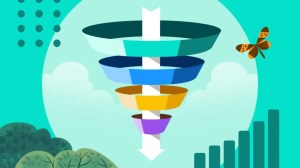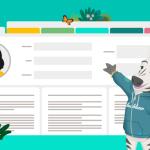What Is a Sales Funnel? (And How to Make It Run Smoothly for Fast Wins)



Don’t let your prospects lose the trail from product discovery to close. Learn how to keep them on track, on pace, and target for a big-win finish.
Imagine a runner getting ready for a big race. She’s familiar with most courses, but not this one. What will the landscape look like? What obstacles will there be? Enter the coach, who has guided countless runners to wins on this very course. He helps her determine the pace and technique necessary to efficiently navigate each stage of the race while avoiding risks.
That’s how a sales funnel works. With the right coaching from a seller who knows the path from awareness to close, prospects can quickly discover, evaluate, and buy a solution that fits their unique needs.
The question, of course, is: How do you know what course your buyers will take? And how do you help them navigate it?
To answer these questions, let’s take a deeper look at the sales funnel — what it is, how to create one, and how it can help you deliver satisfied customers.
What you’ll learn:
What is a sales funnel?
Why is a sales funnel important?
What are the 6 stages of a sales funnel?
How to optimise the sales funnel for your business
Sales funnel example
What tools do you need to optimise your sales funnel?
Drive pipe faster with a single source of truth
Discover how Sales Cloud uses data and AI to help you manage your pipeline, build relationships, and close deals fast.



What is a sales funnel?
A sales funnel is the journey a prospect takes from awareness of a product or service to purchase. Sellers use this funnel to track each prospect’s progress toward close, stepping in to remove blockers and address needs so that they buy the right solution as quickly and smoothly as possible.
It’s important to note that while most sales funnels have the same major stages — like product consideration and evaluation — the way a prospect navigates these stages is heavily dependent on their circumstances, the product or service, the company, and available resources. It’s entirely possible a prospect could bounce among multiple stages before moving ahead, or jump straight from consideration to purchase. Because of these deviations, sellers should think of the sales funnel as a guide — not a one-way path that prospects must follow.
What is the difference between a marketing funnel and a sales funnel?
A marketing funnel is the path target buyers take from initial engagement with marketing efforts — like ads, social media campaigns, or promotional emails — to becoming leads interested in a product or service. The sales funnel picks up from here, focusing on the journey to the final purchase.
What is the difference between a sales pipeline and a sales funnel?
Both sales pipelines and sales funnels outline the journey a buyer takes on the path toward purchase. In fact, they have a lot of overlapping stages. The key difference is the perspective.
A sales pipeline is how reps track, analyse, and guide their engagement with buyers during the sales process. A prospect lingering in the negotiation stage, for example, may need a discount to move them to the contract stage.
A sales funnel is buyer-centric, charting the buying journey from the prospect’s perspective. Think of it like the ongoing conversation the buyer has as they move from stage to stage. They may ask questions like: “Does this solution make sense? How does this help me solve my problem?” Knowing common questions prospects ask as they navigate the sales funnel helps reps deliver high-value answers that move prospects closer to purchase.
Why is a sales funnel important?
Let’s jump back to the running metaphor. If a coach knows a course and a runner’s abilities, they can train them to run at the right pace, ensuring they don’t get exhausted and quit before hitting the finish line.
That’s the value of knowing a sales funnel: Successful sellers understand the journey a prospect is likely to take before they buy, and can make sure they’re ready to move on to each stage. They’re focused on the buyer, meeting their needs in the moment and building trust that helps move the deal forward.
So what if you ditched the sales funnel? You’d run the risk of focusing too much on the close-to-hit quota, pushing products or services when prospects aren’t ready. Win rates would drop because prospects wouldn’t feel comfortable with the solutions they’re offered, and trust would be lost. No long-term relationships, no cross-sells, or upsells.
Join the Salesblazer movement
We’re building the largest and most successful community of sales professionals, so you can learn, connect, and grow.

What are the 6 stages of a sales funnel?
The top of the funnel is where new leads, or prospects, start their buying journey, while the narrow bottom is where leads convert to customers at the end of the sales process. While the stages can vary, a typical model progresses from awareness to consideration and conversion:
- Awareness and discovery: Buyers acknowledge a problem, start searching for a solution to that problem, become aware of your solution, and start asking questions about how your product or service can solve it.
- Interest: Buyers show interest and dive deeper into product/service research.
- Consideration: Buyers dig into the features, implementation details, and cost of what you’re offering to see if it meets their unique needs.
- Intent: The prospective buyer shows signs of wanting to purchase, like signing up for a free webinar or trial.
- Evaluation: The buyer evaluates your solution via hands-on use or demos and compares it to others in the market.
- Purchase: A transaction takes place, marking the transition from prospect to customer.
How to optimise the sales funnel for your business
Knowing the stages of the sales funnel is just the start. Efficiently moving prospects down the funnel is what keeps your deals flowing. Here are four steps to optimise your sales funnel:
1. Determine the best channels for capturing high-quality prospects
Sales funnel tracking is useless if prospects never enter the funnel. To make sure you’re gathering leads most likely to buy, focus your marketing and prospecting efforts on your buyer persona. With this research in hand, determine where your target persona spends their time and what messaging resonates with them. Use this information to create and optimise content, marketing campaigns (ads, emails, social media), and outbound prospecting efforts.
For example, if you sell eco-friendly, reusable grocery bags, create blog content that targets SEO keywords like “sustainable tote bags” so your prospects will find you in search results.
2. Track the behaviour of prospects as they move through the funnel
If you take the time to create a buyer persona, you likely have an idea of how your customer approaches the buying process. This, however, only represents a broad-strokes view of your ideal customer. To get a real-life look at how buyers are coming to your product and making their way to a purchase, track their actions. As they move through each stage, take note of the questions they ask, the information they request, and the requirements they attempt to meet. These reveal prospect needs and pain points you can help address. It also helps you determine the common path prospects take through the funnel; you may need to adjust the common stages noted above to fit your target buyers.
3. Establish criteria for moving through the funnel based on prospect behaviour
Once you understand your target buyer’s behaviour and preferences, you can set clear behavioural criteria for moving from each stage of the sales funnel to the next one. These should be easy to identify and specific to your business or product. The goal here is to have a guide for successful progress through the funnel. If a prospect isn’t meeting the criteria you set, it’s a red flag that should be addressed with additional discovery, negotiation, or incentives.
Here’s a guide to get you started:
- Awareness > Interest: The prospect actively engages with content about your product or service and asks general questions about it.
- Interest > Consideration: Questions become more focused on how the product or service addresses their needs and pain points. The prospect will likely ask for additional materials about the product or service, with information about features/functions and cost.
- Consideration > Intent: The prospect notes that your product/service offers unique value and may be a good fit for them.
- Intent > Evaluation: A request is made to try out the product via demo, trial, or test. The prospect asks more in-depth questions about implementing or using the product/service.
- Evaluation > Purchase: Conversations shift to pricing, payment terms, and purchasing timeline. Proposals are sent and agreed upon. The purchase is finalised.
4. Review sales funnel criteria regularly and make adjustments
Continually monitor and adjust your stage criteria by analysing real-time behavioural changes within the funnel. For example, if a majority of prospects are lingering in the “Consideration” stage and don’t show any intent to purchase, consider diving in with an in-depth discovery call to learn more about paint points you can address.
Sales funnel example
A local running store, SpeedyShoes, has been in business for a few months. They’ve relied mostly on word-of-mouth advertising to bring in customers, but business is still slow.
To help ramp things up, they spend some time putting together a buyer persona they can target in new promotions: a 20-something casual runner who enjoys competing now and again, and loves running with others in their community. With this as a guide, they host a community event with free swag to help bring in area runners (Awareness). Several attendees mention they’ve been looking for a shoe store that specialises in running shoes, and that they’ll be back to check out the inventory (Interest). The store’s owner, Kathy, asks them to sign up for the newsletter so they can get the latest updates.
Of the 100 or so event attendees, 20 come to the store to check out the shoes. Almost everyone is impressed with the quality and inventory, and most end up trying on several pairs (Consideration). Kathy is an avid runner herself so is easily able to answer their questions about the longevity of the shoes, when and where to use them, and how to find the right fit.
But there’s a problem. Kathy finds that, however enthusiastic the prospects are, they almost always balk at the price. At $150+ per pair, Kathy knows the store’s shoes are expensive, but also knows they will last a couple of years at least.
To help get her target buyers over the price hump she offers them a deal: Get 20% off your first pair and if you refer someone else to the store who buys, you get 10% off your next purchase.
As word spreads about the deal, Kathy sees an increase in prospects who ask more probing questions about how the shoes are made, if they’re better for trail or road running, and what kind of return policy the store has (Intent). Many of them ask if they can take a pair or two for a spin around the block, just to get a sense of how they’d perform on a run (Evaluation).
With the discount in hand and first-hand knowledge of how well the shoes handle, it doesn’t take much to get prospects to buy (Conversion). Within the first few months, Kathy sees a 30% increase in sales, with many customers noting they’ll spread the word about SpeedyShoes.
What tools do you need to optimise your sales funnel?
Tracking prospect behaviour to optimise your funnel depends on getting real-time updates on what customers are doing. Let’s be honest: Reps already spend most of their time on non-selling tasks; they don’t have any more time to spend manually tracking and recording this behaviour. To help bring in the data you need, leverage a CRM with real-time data updates, automation, and prospect engagement tools. This allows you to spend your time on nurturing and selling — the actions that ultimately get you done deals.
Here are some essential tools to help you to optimise your sales funnel:
Customer relationship management (CRM) software: This is your main hub for keeping track of customer information. Look for a CRM with the ability to automatically add data from different prospect engagement channels like emails, calls, and chats to deal records.
Real-time sales data and analytics: Like a running coach with a stopwatch, this is how you track sales funnel movement. Analytics, updated in real time, provide invaluable insight into critical sales key performance indicators (KPIs) like conversion ratios, the lifespan of deals, and the influx of qualified leads. It can also help you track prospect movement from one funnel stage to the next. AI-powered recommendations, based on the customer data you collect, show you exactly what you need to do to keep customers moving down the funnel.
Sales enablement tools: From sales training platforms to coaching modules, these tools equip reps with the sales knowledge and product expertise to answer prospect questions, wherever they sit in the sales funnel. Effective sales enablement also includes recommended strategies for handling objections, obstacles, and hiccups throughout the sales process.
Sales engagement tools: Build and maintain relationships with prospects through email, chat, or phone, and track every conversation for richer insights. The best sales engagement tools automate a lot of the manual work, updating deal records with the latest prospect messages and drafting emails tailored to each lead with the help of generative AI.
Lead nurturing tools: Prospects not ready to buy? Don’t waste time on manually cranking out communication to move them forward. Leverage lead nurturing tools that push out scheduled content, personalised email campaigns, and valuable resources that help them convert.
You’ve got a well-oiled sales funnel — now go win the race
At its core, a sales funnel is about understanding how customers process the pros and cons of buying in their own minds. That’s why it must be central to the selling process. With the customer as the focal point and data-driven insights in hand, sales reps can guide prospects effortlessly through the funnel, maximising sales while building strong, lasting relationships.
What trends drive sales productivity today?
Get the State of Sales Report to discover productivity insights from 7,700 sales professionals.

























